Millions of people in the UK are affected by varying degrees of hearing loss. The problem can range from complete deafness, where the quietest sound heard is over 90 decibels loud to mild hearing loss, where some degree of normal conversation is still possible. Though hearing aids cannot restore initial auditory conditions, they can significantly improve the quality of life for the wearer.
Hearing aids have come a long way. At one time, horn-like objects were used to amplify sound for the hearing impaired. Today, those with hearing loss have a dizzying range of options from discreet behind-the-ear devices to tiny hearing aids that are fitted into the ear canal. We have reviewed four top behind the ear hearing aids with varying features and budgets.
Best hearing aid reviews – Our Top Picks
1. Med-Fit Rechargeable Behind-the-Ear Hearing Aid
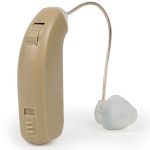 The one feature that stands out in thus ultra-affordable hearing aid is the rechargeable battery. There is no need to keep buying new batteries. When the battery dies, just recharge it and you are good to go. This provides a bit more convenience compared to other hearing aids and saves money.
The one feature that stands out in thus ultra-affordable hearing aid is the rechargeable battery. There is no need to keep buying new batteries. When the battery dies, just recharge it and you are good to go. This provides a bit more convenience compared to other hearing aids and saves money.
It is designed to combat moderate hearing loss through sound amplification. A volume adjust button allows the wearer to change the level of sound output depending on the environment. Three different plug sizes are provided so that if one doesn’t fit, you can try on another. The entire unit is quite small and very discreet when worn.
Unfortunately, it may not be helpful for those with advanced and severe hearing loss. Read our full review of Med-Fit Hearing Aid.
2. Beurer HA50 Hearing Amplifier
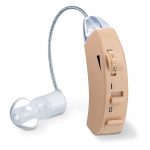 This is the perfect hearing aid for people who are just starting to experience low levels of hearing loss. It costs only a fraction of the price of traditional hearing aids. If you have mild hearing loss and do not want to spend on expensive hearing aids, this is a recommended choice.
This is the perfect hearing aid for people who are just starting to experience low levels of hearing loss. It costs only a fraction of the price of traditional hearing aids. If you have mild hearing loss and do not want to spend on expensive hearing aids, this is a recommended choice.
A volume control button lets you choose how high or low the sound output is. This button is handy when you are in a noisy place and need to hear well. Its small size provides a discreet way to wear it especially for those who feel insecure about wearing a hearing aid.
For those with severe hearing loss, this hearing aid may not help much. It is designed only for mild hearing impairment. Read our full review of Beurer HA50 Hearing Amplifier.
3. HD400 Digital Micro Behind-the-Ear Hearing Aid
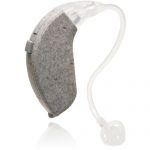 This is an affordable yet powerful hearing aid designed for mild to moderate hearing loss. Its most notable feature is the ability to detect human voice and optimise it for better hearing. It cancels out background noise, ensuring that the wearer can still communicate well in noisy places.
This is an affordable yet powerful hearing aid designed for mild to moderate hearing loss. Its most notable feature is the ability to detect human voice and optimise it for better hearing. It cancels out background noise, ensuring that the wearer can still communicate well in noisy places.
There is also a telecoil embedded in the hearing aid. It helps in places like theatres and when talking on the phone where it transmits sound directly to the hearing aid.
Like all other hearing aids we have reviewed, the small size is both a blessing and an occasional curse. While it is discreet, it can also get lost easily. Read our full review of HD400 Digital Micro Hearing Aid.
4. HD210 Digital Micro Behind-the-Ear Hearing Aid
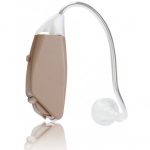 This is a more affordable alternative to the HD400 hearing aid. It comes with the same discreet design, volume control button for personalised hearing, human speech optimisation and background noise cancellation.
This is a more affordable alternative to the HD400 hearing aid. It comes with the same discreet design, volume control button for personalised hearing, human speech optimisation and background noise cancellation.
For increased comfort, the plug that goes into the ear features an open-dome design to maintain air flow and prevent sweat build-up.
The only trouble you might run into is putting in the battery. Both the battery and battery compartment are tiny. Read our full review of HD210 Digital Micro Hearing Aid.
5. Beurer HA20 Hearing Amplifier
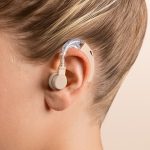 The Beurer HA20 is a cheap but effective hearing amplifier. It is designed to help with mild hearing impairment in elderly persons or anyone with reduced hearing. It’s light and compact, ensuring it doesn’t feel or look awkward on your ear.
The Beurer HA20 is a cheap but effective hearing amplifier. It is designed to help with mild hearing impairment in elderly persons or anyone with reduced hearing. It’s light and compact, ensuring it doesn’t feel or look awkward on your ear.
There are three differently sized earplugs for a perfect fit and the outer part fits securely behind your ear without constantly falling out.
If you are looking for a simple, affordable but good quality hearing amplifier, the Beurer HA20 is a great choice. The sound quality is not very natural (a bit synthetic especially at a higher volume) but at least you’ll be able to hear clearly.
Read our full review of Beurer HA20.
Hearing aid buying guide
Hearing loss varies from person to person. Hence it is essential to undergo a hearing test before you decide which type of hearing aid to buy. An audiologist will test how well you can hear and establish your specific severity of hearing loss. Based on the diagnosis, you may be recommended for further medical tests or be advised to use a hearing aid.
This brief guides you around the types and features of hearing aids and how to buy the right one for your needs.
Types of hearing aids
Before we had the tiny digital hearing aids you see today, people with hearing loss had to rely on conical trumpets. There were many more such sound amplifying devices developed before the electronic hearing aid was invented.
The invention of the telephone in the late 1800s paved the way for the development of the modern hearing aid. From the first electronic aid in 1898, numerous developments took place in the 20th century culminating in the much acclaimed transistor hearing aid in the 1950s.
Technological developments towards the beginning of the 21st century (1960s-1990s) opened the door for modern digital hearing aids. Unlike analogue electric hearing aids, digital hearing aids contain microprocessors that replicate sounds from the environment rather than just amplifying them.
Today, hearing aids can be broadly classified into analogue and digital hearing aids. However, digital hearing aids have become ubiquitous and the preferred choice for many physicians and those with hearing loss. That is why we are going to focus on digital hearing aids starting with the various types available in the market.
Types of digital hearing aids
1. Behind-the-ear (BTE) with earmold
The main part of a BTE hearing aid is a plastic case that rests behind the ear. This is where most of the electronics and controls are located. A small piece of clear tubing connects the case to a customised earpiece or mould fitted inside the ear canal. This type of hearing aid is the most common today and is ideal for moderate to severe hearing loss.
One of the obvious advantages of this design is versatility. Different sizes of earpieces can be connected to the external plastic casing. This is especially beneficial for children whose earmoulds will need to be changed as they grow up. BTE hearing aids are also remarkably sturdy, a big advantage for kids and those doing manual work.
On the downside, the hearing aid is fairly conspicuous by modern standards. For users without long hair, the size can be a bit uneasy. Some users also tend to feel an uncomfortable ‘plugged up’ sensation. Addition of vents in the mould can help with this.
2. One-the-ear (Mini BTE) hearing aids
Mini BTEs, as you might have guessed, are smaller versions of traditional behind-the-ear hearing aids. They have a much smaller casing with a less noticeable tubing. The tube connects to either an on-the-ear earpiece (called open fit) or a traditional mould inside the ear canal.
The open fit design is ideal for mild to moderate hearing loss while the traditional earmould design is perfect for those who want the advantage of traditional BTE hearing aids but with the low profile aesthetics of Mini BTEs.
The main disadvantage of Mini BTEs, particularly the open fit earpieces, is the increased risk of coming lose especially when undertaking a vigorous activity such as running or manual work. If used with children, they can easily get lost.
3. RITE (Receiver-in-the-ear) hearing aids
These are quite similar to BTE hearing aids with one stark difference; the receiver unit is located inside the ear rather than in a plastic casing behind the ear. Plastic tubing is replaced by thin electrical wires connecting the outer small casing with the receiver in the canal. This results in better sound processing and lesser distortion. It is ideal for all forms of hearing loss from mild to severe.
The main advantage of RITE hearing aids is their ultra-discreet design. Since some parts of the unit are inside the ear canal, the outer unit significantly scales down in size. For those concerned with BTE hearing aids (both standard and mini), this is a great alternative.
The disadvantage of RITE hearing aids is the increased risk of damage from sweat and wax. This can affect the sound quality and will require a higher level of maintenance.
4. ITE (in-the-ear) hearing aids
In ITE hearing aids, the whole unit goes inside the ear. This includes the mould and receiver. It is important to note that the unit does not go into the canal; rather it is fitted on the outer portion of the ear. They are ideal for mild to severe hearing disability and will often be custom made to fit unique ear proportions.
ITE hearing aids are very discreet to the point of being completely unnoticeable to other people. On the downside, they tend to get easily affected by sweat and wax, thus requiring more frequent cleanings and repairs.
5. ICE (in-the-canal) hearing aids
These are much smaller hearing aids, designed to fit into the ear canal with only a small part left in the outer ear. While the small size makes them virtually unnoticeable to other people and can offer certain sound advantages, it also makes them harder to handle and control. Because of unique ear shapes and sizes, ICE hearing aids need to be custom fitted to each individual.
6. CIC (completely-in-the-canal) hearing aids
These are much smaller versions of ICE hearing aids and are ideal for mild to moderate hearing loss. All parts of the hearing aids are located inside an ear mould which is then fitted inside the canal. CIC hearing aids are the smallest available, with an obvious advantage of being completely unnoticeable.
But the small size comes with a number of disadvantages. For one, they get plagued a lot by wax and sweat and can sometimes feel uncomfortable. For people with a history of frequent ear infections, this type of hearing aid is not recommended. The tiny buttons can also be difficult to manipulate, especially for elderly users.
Other types
The above are the major options available when you are looking for hearing aids. There are additional lesser-known types that come with unique features and designed to meet specific needs. For example, tinnitus masking hearing aids are designed to do exactly that, mask the effect of tinnitus. There are also bone conduction hearing aids that send sound vibration through your skull to the inner ear. They can be attached to glasses or worn on a headband.
Others include CROS and BiCROS for those with hearing loss in one year, bulky analogue hearing ides often used for those with visual impairment and cochlear implants that are surgically implanted in the inner ear.
Features of hearing aids
As you search for the right hearing aids, you will no doubt come across a myriad of features that you need to take into account. Here is a brief explainer for all the essential features you should keep in mind.
1. The basics
There are some basic features to expect in any hearing aid. They include a microphone to pick up sound signals in the environment and convert them into electric signals; an amplifier to process and amplify incoming signals; and an ear receiver to receive the processed digital signal and turn it into a sound wave that the wearer can hear.
These are the most essential aspects of a hearing aid. They can be located in a casing behind the ear (BTE and Mini BTE hearing aids) or in a unit fitted inside the ear (ITE, ICE and CIC hearing aids). In addition to these parts, hearing aids will also have buttons to control sound settings and turn the unit on/off as well as a battery compartment to power the unit.
2. Specialised features
Depending on your preferences and hearing needs, there are some specialised features you might want in your hearing aid.
- Vents – these are added to in-ear moulds to allow free airflow and prevent a ‘plugged up’ sensation. They are especially helpful if you tend to sweat a lot inside the ears.
- Wax guard – a replaceable filter used to keep ear wax from getting into inner hearing aid components. It reduces frequency of cleanings and lengthens the durability of the hearing aid.
- Directional microphone – if you have trouble carrying on a conversation in a noisy area, even with your hearing aids on, a directional microphone can come in handy. It picks up sound signals from a specific direction, such as from the person in front of you, thus muting disruptive sounds from other sources.
- Automatic adaptation – this feature allows a hearing aid to adapt itself to your ear automatically over time. This removes the need to keep going back to the audiologists for settings adjustment.
- T-coil – this allows better hearing when using a landline telephone. Sound is transmitted directly to the T-coil in your hearing aid instead of the microphone. This eliminates background sounds and delivers a crisp sound when using the phone.
- Bluetooth and direct audio input – with direct audio output, you can connect your hearing aid directly with gadgets like the TV, MP3 players, Radio and even your mobile phone. This connection can be achieved through a wired connection or via Bluetooth.
There are many more features that we cannot possibly cover in a single guide. Thanks to technology, hearing aids have become more powerful and efficient than ever before. Users have a dizzying range of options and features to choose from.
Important buying tips
The first step before you decide to get hearing aids is to pay your GP a visit. He or she will run an initial diagnosis to rule out temporary problems. Based on the results, you might be referred to an audiologist, who will give you a hearing test and carry out a more comprehensive diagnosis. A hearing test establishes your level of hearing loss and determines what kind of hearing aids you need to meet your needs.
If you are getting your hearing aids from the NHS, you will get fitted with hearing aids free of charge. Follow up care, which includes adjustments, repairs and battery replacements, is also free. Some clinics even have at-home services though this will require a letter from your GP.
The disadvantage with getting your hearing aids from the NHS include limited choice, waiting times before you get hearing aids and delays when you go for follow-up visits. For these and other reasons, more and more people are opting to go private.
1. Should you buy a hearing aid privately?
While you can bypass your GP when buying a hearing aid from a private seller, we would recommend seeing the doctor as the first step. This will eliminate the possibility that it is a temporary problem and will help narrow down your options.
Most private providers carry out hearing tests of their own to determine your exact problem and the best solution. The catch with getting your hearing aids privately is that it will cost more money. This includes the cost of consultation, initial purchase, battery replacements, follow-up maintenance and unit replacement costs every 3-5 years.
On the upside, you get more freedom of choice. If your budget allows it, you can get a high-end hearing aid, which might not be possible with the NHS option. You also do not have to experience delays and long waiting times when it comes to getting your hearing aids and follow up appointments.
If you go private, make sure the provider is a member of Health and Care Professions Council. Ideally, they should also be registered at British Society of Hearing Aid Audiologists, though this is voluntary. Also check that the audiologist has a good reputation.
2. How to clean hearing aids?
The three things you’ll need to clean your hearing aid are a small brush (likely included with your hearing aid) with a pick at one end, a soft cloth and a vent cleaning tool.
If you have a BTE (behind the ear) hearing aid, you may also need a hearing aid blower to clean and dry the tube.
Here are general hearing aid cleaning steps.
- Using the small brush, clean the surface of the hearing aid. Focus on any ports and openings, including the microphones, to ensure good sound quality. Also use the brush to clean the mould of a BTE hearing aid.
- Use the vent cleaning tool to remove wax from any of the openings. This prevents the common whistling issue hearing aid users experience.
- Use the soft cloth to gently wipe all parts of the hearing aid.
- If there is wax or debris in the tube of your BTE hearing aid, disconnect the tubing from the main part. Wash the tube and mould in warm soapy water. Use a blower to dry water inside the tube and wipe the outside with a soft cloth.
- If you have a Receiver in the Canal (RIC) hearing aid, check the condition of the wax guard. If it is worn out or no longer working properly, replace it.
3. Why do hearing aids whistle?
The most common reason hearing aids whistle is wax blockage in the vents and microphone ports. It causes sound to be deflected back to the hearing aid, which results in a screeching or whistling sound.
Clean your hearing aid 2-3 times a week.
An ill-fitting hearing aid, high volume or an improperly fitted hearing aid can also cause hearing issues.
If the whistling occurs only when your hear is close to objects such as a scarf or when you put your hand close to your ear, that’s a sound feedback issue. It shouldn’t affect your overall use of the hearing aid.
4. Why are hearing aids so expensive?
Research and development is one of the main reasons hearing aids are still so expensive, despite cheaper manufacturing and technological advancements.
Manufacturers spend millions per year on improving hearing aid technology.
The problem is, most expensive hearing aids are over-engineered. Cheaper hearing aids can work just as well for people with mild to average hearing loss.
The high cost drives most people to the much cheaper hearing amplification devices (which can cost as little as £20 compared to the more than £1,000 price tag of medical hearing aids).
The good news is that hearing amplifiers have also been improving to the point that people with mild hearing loss can use them without any serious limitations in hearing performance.
Conclusion
We have come a long way from trumpets, thanks to dedicated experts and endless innovation. Today, those with hearing loss need not experience reduced quality of life. With hearing aids, they can easily interact with their friends, family and colleagues. Hopefully, out guide has provided valuable insights into the wide world of hearing aids.
